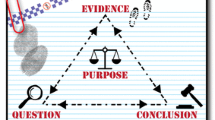Abstract
This paper argues for a renewed focus on statistical reasoning in the beginning school years, with opportunities for children to engage in data modelling. Results are reported from the first year of a 3-year longitudinal study in which three classes of first-grade children (6-year-olds) and their teachers engaged in data modelling activities. The theme of Looking after our Environment, part of the children’s science curriculum, provided the task context. The goals for the two activities addressed here included engaging children in core components of data modelling, namely, selecting attributes, structuring and representing data, identifying variation in data, and making predictions from given data. Results include the various ways in which children represented and re-represented collected data, including attribute selection, and the metarepresentational competence they displayed in doing so. The “data lenses” through which the children dealt with informal inference (variation and prediction) are also reported.


Similar content being viewed by others
References
Bethel, E. (2008). Michael recycle. Mascot, Australia: Koala Books.
Bethel, E. (2009). Litterbug Doug. Mascot, Australia: Koala Books.
Cobb, P. (1999). Individual and collective mathematical development: The case of statistical data analysis. Mathematical Thinking and Learning, 1(1), 5–43.
Cobb, G. W., & Moore, D. S. (1997). Mathematics, statistics, and teaching. The American Mathematical Monthly, 104, 801–823.
Cooper, B., & Dunne, M. (2000). Assessing children’s mathematical knowledge: Social class, sex and problem solving. Buckingham, UK: Open University.
Curcio, F. R. (2010). Developing data-graph comprehension in grades K–8. Reston, VA: National Council of Teachers of Mathematics.
diSessa, A. A. (2004). Metarepresentation: Native competence and targets for instruction. Cognition and Instruction, 22(3), 291–292.
diSessa, A. A., Hammer, D., Sherin, B., & Kolpakowski, T. (1991). Inventing graphing: Metarepresentational expertise in children. The Journal of Mathematical Behavior, 10, 117–160.
English, L. D. (2003). Reconciling theory, research, and practice: A models and modelling perspective. Educational Studies in Mathematics, 54(2 & 3), 225–248.
English, L. D. (2010). Young children’s early modelling with data. Mathematics Education Research Journal, 22(2), 24–47.
English, L. D., & Watters, J. J. (2005). Mathematical modelling in third-grade classrooms. Mathematics Education Research Journal, 16(3), 59–80.
Franklin, C. A., & Garfield, J. (2006). The GAISE project: Developing statistics education guidelines for grades pre-K-12 and college courses. In G. Burrill & P. Elliott (Eds.), Thinking and reasoning with data and chance (68th Yearbook) (pp. 345–376). Reston, VA: National Council of Teachers of Mathematics.
Garfield, J., & Ben-Zvi, D. (2007). How students learn statistics revisited: A current review of research on teaching and learning statistics. International Statistical Review, 75(3), 372–396.
Hancock, C., Kaput, J. T., & Goldsmith, L. T. (1992). Authentic inquiry with data: Critical barriers to classroom implementation. Educational Psychologist, 27(3), 337–364.
Hanner, S., James, E., & Rohlfing, M. (2002). Classification models across grades. In R. Lehrer & L. Schauble (Eds.), Investigating real data in the classroom (pp. 99–117). New York, NY: Teachers College.
Konold, C., & Higgins, T. L. (2003). Reasoning about data. In: J. Kilpatrick, W. G. Martin, & D. Schifter (eds.). (2003). A research companion to principles and standards for school mathematics. Reston, VA: National Council of Teachers of Mathematics.
Langrall, C., Mooney, E., Nisbet, S., & Jones, G. (2008). Elementary students’ access to powerful mathematical ideas. In L. D. English (Ed.), Handbook of international research in mathematics education (2nd ed., pp. 109–135). New York, NY: Routledge.
Langrall, C., Nisbet, S., Mooney, E., & Jansem, S. (2011). The role of context expertise when comparing data. Mathematical Thinking and Learning, 13(1), 47–67.
Leavy, A. (2007). An examination of the role of statistical investigation in supporting the development of young children’s statistical reasoning. In O. Saracho & B. Spodek (Eds.), Contemporary perspectives on mathematics in early childhood education (pp. 215–232). Charlotte, NC: Information Age Publishing.
Lehrer, R., & Lesh, R. (2003). Mathematical learning. In W. Reynolds & G. Miller (Eds.), Comprehensive handbook of psychology (Vol. 7, pp. 357–390). New York: John Wiley.
Lehrer, R., & Romberg, T. (1996). Exploring children’s data modeling. Cognition and Instruction, 14(1), 69–108.
Lehrer, R., & Schauble, L. (2005). Developing modeling and argument in the elementary grades. In T. Romberg, T. Carpenter, & F. Dremock (Eds.), Understanding mathematics and science matters (pp. 29–53). Mahwah, NJ: Lawrence Erlbaum Associates.
Lehrer, R., & Schauble, L. (2006). Cultivating model-based reasoning in science education. In R. K. Sawyer (Ed.), The Cambridge handbook of the learning sciences (pp. 371–386). NY: Cambridge University Press.
Lehrer, R., & Schauble, L. (2007). Contrasting emerging conceptions of distribution in contexts of error and natural variation. In M. C. Lovett & P. Shah (Eds.), Thinking with data (pp. 149–176). New York, NY: Taylor & Francis.
Lesh, R. A., & Kelly, A. E. (2000). Multi-tiered teaching experiments. In R. A. Lesh & A. Kelly (Eds.), Handbook of research design in mathematics and science education (pp. 197–230). Hillsdale, NJ: Lawrence Erlbaum Associates.
Lesh, R., & Lehrer, R. (2000). Iterative refinement cycles for videotape analyses of conceptual change. In R. Lesh & A. Kelly (Eds.), Research design in mathematics and science education (pp. 665–708). Hillsdale, NJ: Lawrence Erlbaum Associates.
Makar, K., & Rubin, A. (2009). A framework for thinking about informal statistical inference. Statistics Education Research Journal, 8(1), 82–105.
Moore, D. S. (1990). Uncertainty. In L. Steen (Ed.), On the shoulders of giants: New approaches to numeracy (pp. 95–137). Washington, DC: National Academy Press.
Olson, D. R. (1994). The world on paper. Cambridge, UK: Cambridge University Press.
Pfannkuch, M. (2005). Thinking tools and variation. Statistics Education Research Journal, 14(2), 5–22.
Pfannkuch, K. (2011). The role of context in developing informal statistical inferential reasoning: A classroom study. Mathematical Thinking and Learning, 13, 1–2.
Rubin, A., Hammerman, J., & Konold, C. (2006). Exploring informal inference with interactive visualization software. In: A. Rossman & B. Chance (Eds.), Working cooperatively in statistics education. Proceedings of the Seventh International Conference on Teaching Statistics. Salvador, Brazil. [CDROM]. Voorburg, The Netherlands: International Statistical Institute.
Russell, S. J. (1991). Counting noses and scary things: Children construct their ideas about data. In D. Vere-Jones (Ed.), Proceedings of the Third International Conference on the Teaching of Statistics (pp. 158–164). University of Otago: Dunedin, NZ.
Shaughnessy, J. M. (2010). Statistics for all: The flip side of quantitative reasoning. Retrieved 14 August, 2010, from http://www.nctm.org/about/content.aspx?id=26327
Strauss, A., & Corbin, J. (1990). Basics of qualitative research: Ground theory procedures and techniques. CA: Sage.
van den Heuvel-Panhuizen, M., & van den Boogaard, S. (2008). Picture books as an impetus for kindergartners’ mathematical thinking. Mathematical Thinking and Learning: An International Journal, 10, 341–373.
Watson, J. M. (2006). Statistical literacy at school: Growth and goals. Mahwah, NJ: Lawrence Erlbaum Associates.
Watson, J. M. (2007). Inference as prediction. Australian Mathematics Teacher, 63(1), 6–11.
Acknowledgements
The project reported here is supported by a 3-year Australian Research Council (ARC) Discovery Grant DP0984178 (2009–2011). Any opinions, findings, and conclusions or recommendations expressed in this paper are those of the author and do not necessarily reflect the views of the ARC. I wish to acknowledge the enthusiastic participation of the classroom teachers and their first-grade students, as well as the excellent support provided by my senior research assistant, Jo Macri. Professor Jane Watson’s advice (personal communication) on the statistical learning of young children is also gratefully acknowledged.
Author information
Authors and Affiliations
Corresponding author
Rights and permissions
About this article
Cite this article
English, L.D. Data modelling with first-grade students. Educ Stud Math 81, 15–30 (2012). https://doi.org/10.1007/s10649-011-9377-3
Published:
Issue Date:
DOI: https://doi.org/10.1007/s10649-011-9377-3




